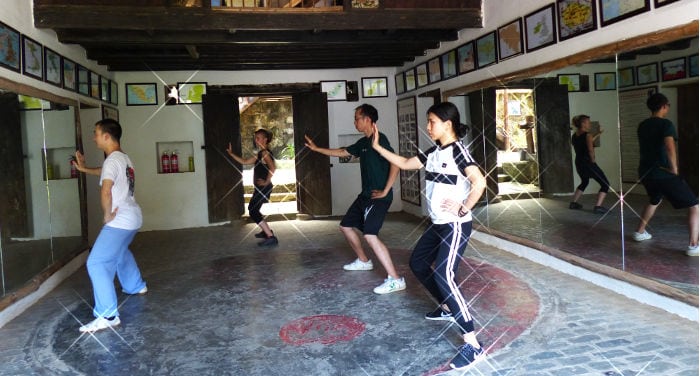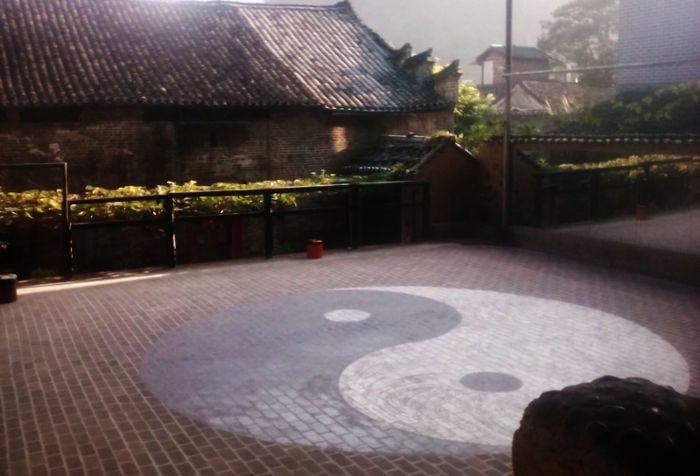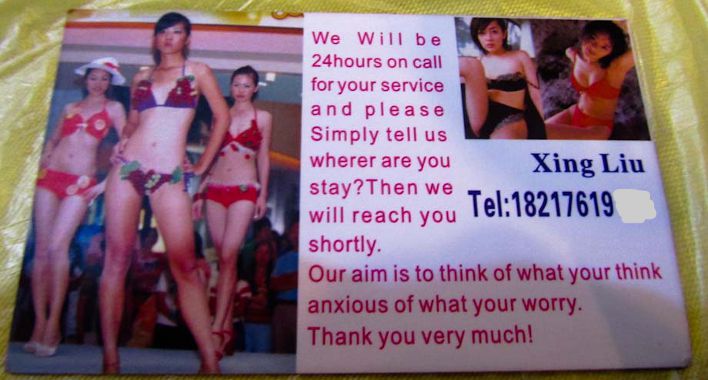
In this article, after a brief overview of Yangshuo and Tai Chi, I will go on to describe in detail the four Tai Chi schools in Yangshuo (personally I only attended the first three).
At the end, I will illustrate the criteria to keep in mind when choosing the best school for you and the course costs for Tai Chi in Yangshuo.
Why study in Yangshuo?
Yangshuo is a famous (at least among the Chinese) tourist destination in the region of Guangxi along the banks of the Li River (Li Jiang). The draw is that it is set between the river and granite formations unique in the world to the point of being recognized by the UNESCO World Heritage List.
In 2015 11 million tourists went to see these rocky “protuberances” down intersecting rivers (Li being the bigger one), the majority of which were Chinese. There’s certainly no lack of foreigners, but as opposed to how things were up to a decade ago, they have the same dilution as a drop of tap water in the Pacific Ocean.
This tourist attraction is (by Chinese standards) a small town of about 200,000 inhabitants, and has its pros and cons. The most obvious con is that especially during the summer season (from June through August), the crowds are overwhelming just about everywhere.
Especially on West Street (the main shopping drag) its like being front row at a popular star’s concert. This makes prices soar, prices that go back down quickly at the end of the season when sellouts only happen on weekends and Chinese holidays.
There are lots of pros, which in my opinion are the difference makers:
- The air is good, in fact there aren’t any factories because tourism is their true business and tourism is full of restaurants hotels and stores;
- You can easily find all you need because, being a small city, everything is close and easily found in a short walk;
- Ten minutes on a bicycle and you’re in the middle of the Chinese countryside with its rice terraces and its farms and you can take memorable excursions in small country villages rich with ancient and modern buildings (remember your umbrella and/or sunscreen and a hat depending on the situation);
- There are job opportunities for foreigners who can easily enough find work as English teachers (especially if you’re a native speaker) or full or part time baristas in the various pubs in the center (the Chinese love being served by a laowai);
- You’ll have a vast selection of clubs and bars in which you can satisfy vices of any nature and meet people from around the world.
These favorable conditions together with a surprising landscape attract many long-term visitors and make Yangshuo an ideal place for lengthy stays.
The presence of many long-tern tourists has made it so that in Yangshuo many activities have been developed to fill the days with courses of varying nature and lengths. Along with courses of Chinese language, Chinese cooking, Chinese medicine, calligraphy, origami, there also schools for Tai Chi (or Taiji).

Tai chi Quan Chen Style – From the past until today: 500 years of history
Tai Chi is an ancient Chinese martial art developed in a village called Chenjiagou located in Henan province, in North-Central China.
The earliest historical information dates back to the second half of 1500 when, a general by the name of Chen Wang Ting, had codified this unique style with the intention of creating a fighting style to defend the village and its inhabitants from the continuous raids from various bands of marauders.
Merging martial techniques, which in China were already widely practiced and developed with precepts in the great classics of Chinese philosophy such as the book of changes and the Dao Te Qing and its Yin Yang duality, he developed his peculiar style known as Tai Chi Chen that was passed down by the Chen family throughout the generations up to our day.
The main characteristic that distinguishes it from other martial arts is it’s internal style (as opposed to the arts that are defined as being of an external style) which requires, more than physical strength, deep concentration focused on the development and flow of Qi (internal vital energy) which, when sufficiently mastered, allows one to strike extremely precise and powerful blows.
This characteristic makes it particularly suitable for any age or physical condition.
There are four grand masters of the Chen family that constitute the nineteenth generation (the eleventh in the line of direct succession) and their names are Chen Xiao Wan, Chen Zhen Lei, Wan Xi An and Zhu Tiancai. They were born and raised in the same village called Chenjiagou (village of the Chen family) in honor of their illustrious ancestors.
For a deeper and complete history on the evolution of Tai Chi Chen, I’ll send you to another article because it merits its own consideration. Here I will move on to speaking about the tai chi schools in Yangshuo relating my personal experience developed over nearly a year of intense daily study.
Tai Chi schools in Yangshuo
There are four schools, three of which offer the possibility of staying overnight and serve meals or alternatively, allow the use of a kitchen. In principle, the student can stay inside the school the entire time without needing to leave to take care of their basic needs.
The school that doesn’t have beds or cafeteria can take care of the student all the same in nearby external structures, but doesn’t provide food.
I have firsthand experience in three schools and I met and spoke with people who have studied in the fourth. I prefer to share my firsthand experiences here with only brief nod to the school I didn’t personally stay in.
Traditional Yangshuo Tai Chi School
The location is very beautiful even though it’s only about 5 Km from the city. It’s set in a village (in all there’s no more than ten houses) called Jima which can be reached by going straight from the Yangshuo exit along Long Yue Road.
The school is in an ancient building that, besides giving an artistic touch and throwing you into a dimension out of time, helps to deal with the summer heat and winter cold (which truthfully isn’t too intense since it only goes down to 5 or 6 degrees at the most) thanks to walls that are often a meter or more thick made of pure stone.
The two main masters (Ping and Kim) are friendly and prepared, and have made the school into a very welcoming atmosphere, is orderly and clean (certainly high by Chinese standards). The cook, Kun, is always working, with very appetizing lunches and dinners.
He always makes, aside from the soup of the day and the inevitable rice, various dishes for all tastes where omnivores, vegetarians and vegans can fill their needs.
Their lessons start with a warm-up of about 30 minutes followed by the study of form. It starts with 18 movements moving on to 74.
In my opinion the Tai Chi teaching method is very (or perhaps too much) westernized since, to keep the lessons from becoming too boring, they move on too quickly to teach forms without extensively practicing the basic exercises that would be repeated indefinitely, and for mastery (even partial) would require months of daily practice.
On the other hand it’s a nice thing, which doesn’t happen in other schools, you’re immediately thrown into the applications with real encounters of push hands that give you an idea as to how Tai Chi competitions are held and the techniques are learned in the forms. The masters follow the Chen Zheng Lei style but don’t have the lineage, not having studied directly under him.
Click here to visit the school website.
Tai Chi & Qi Gong Health Center
Although located in the city center just a few steps from the city’s main park and West Street, the city’s main hub, it has ample green spaces and doesn’t have the chaos and noise from the comings and goings of all those tourists.
The practice are is a large open space covered by a roof and surrounded by an ample green space that makes it quite pleasant. This is the school that doesn’t have rooms or a kitchen which makes it a bit scattered for those wanting to immerse themselves in complete concentration.
The master, Wang Zhi Ping, is a bit particular and I would define him as “exceedingly Chinese”. He’s quite (euphemistically) attached to money and, in the beginning, not very cordial, slowly reveals himself and the first necessary approach is a dose of patience because he loves to put you to the test before fully accepting you as a student.
Even though his English is at the limit of comprehension with a vocabulary of about ten words in all, he still manages to make himself understood thanks to universal body language and the innate expressive gifts of his face and his looks.
His strength is Qi Gong Shaolin Kung Fu, whose first form is learned only by the Yi Jing Jin. He studied in Shaolin and in these practices he is well-prepared and seems to be exclusive among the various schools of Yangshuo; in fact he’s the only one who teaches it.
He also teaches the Yang style with great capacity and a good method, which makes it interesting for those that then, upon returning home, want to continue their study; since the Yang style is the most widely practiced and is the easiest to find a good teacher (however not to these levels) in most western coutries.
For the Chen style follow the Chen Zheng Lei style whose lineage goes back to the twelfth generation.
Click here to visit the school’s website.
Tai Chi Travel (formerly called Huang Hua Tai Chi Academy)
This is in Tian Jia He about 2 Km from the center. The location is very convenient because it’s in the countryside, but at the same time near the city. You can sleep in rooms that are quite big and comfortable in a building built about three years ago.
It also offers meals (honestly they’re not that great but still acceptable) or the use of the kitchen if you want to cook for yourself. The master, Huang Hua, also called Henry, speaks English very well and has twelfth generation lineage to Wan Xi An, who achieved after having studied directly from him in Chenjiagou.
He’s very nice and since he married a French woman and also lives in France, he knows how to speak and treat Europeans on the same level. I should mention however that recently he’s spent long periods in France and the school was being taught by a different teacher (Tina Tang), who is also very well quaified and follows the same method to the letter; although she obviously is at the teacher level, not a master.
Excluding the rooms, which as I’ve mentioned were comfortable, spacious and clean, the rest of the setting (kitchen, garden, gym, etc) isn’t the greatest and you need to be ready to adapt to the Chinese lifestyle. This is the school where I spent the majority of my time because, in my opinion, their method of teaching Tai Chi allows for successful learning and the improvement that comes from daily practice.
The lessons include a complete warm-up and the study and daily repetition of basic exercises (Chang Si Jin) which then move on to the forms at another time.
They initially teach forms of 8 movements (in the first month) and then 21 movements (in the first 2 or 3 months); moving on to 74 (which takes at least 4 or 5 months). Certainly, if you’re expecting to throw kicks and punches like rain you might find their teaching method a bit boring, but when it’s time to apply the techniques learned you’ll thank the master and see that your patience was not in vain.
When just arriving from Europe it takes an adaptive spirit;but to truly learn Tai Chi Chen Kung Fu it is, by a long shot, the best place I’ve seen up to now.
In addition it is the only one that follows the style of Wan Xi An (the other masters follow the style of Chen Zheng Lei) which I personally like very much compared to the Chen Zheng Lei style since I consider it to be more powerful since it grants lower positions and has greater offensive possibility.
Yangshuo Tai Chi & Kung Fu School
Of the various schools in Yangshuo, this is the only one where I haven’t attended. I can therefore only pass on “secondhand” information.
The school is in the village of Shibanqiao, reachable via the road next to the Li River going against the current for about 6 or 7 Km, following signs for the school. The main master, Fu Nengbin, offers Tai Chi Chen courses in the Chen Zheng Lei style that has lineage going back twelve generations.
There’s limited lodging capacity which is made up for by taking advantage of the numerous hostels in the village. The small town is very characteristic and is a great setting for a school stay.
The difficulty finding information about the cost, even when going directly to the school makes it a little suspicious and raises doubts that they are “personalized”. Sadly I can’t give any advice on the methods or seriousness of the teaching since I haven’t experienced it directly.
Click here to visit the school’s web site.
How to choose a school
Besides small differences, generally speaking all the schools have the same hours, which consist of fours hours of instruction with two in the morning (from 9 to 11) and two in the afternoon (from 15 to 17), with small variations of about a half an hour during the summer and winter periods (in summer they start earlier and end later).
All schools offer stays of the length requested by the student, from a minimum of just one hour to an unlimited amount of time.
I recommend staying at least two or three months (with an absolute minimum of one month), otherwise you’ll have just a little taste without managing to master much, since Tai Chi is an art that requires years of daily dedication.
To make a wise choice in selecting a school, you must consider your starting point:
- If you can’t even do a conform and/or you only want a taste of Tai Chi as a martial art and piece of Chinese culture, and want to decide later on of you want to take it any further, then I recommend the Traditional Yangshuo Tai Chi School where you can have a rather complete overview of all that concerns learning this art. The lessons are more varied and never boring, with much practical application. They include real matches of fighting push hands (which is Tai Chi Kung Fu), both with the masters and among the students.
- If you would prefer studying Qi Gong, more as a way to reach and maintain both physical and mental well-being and you’re not very interested in the martial art aspect, I recommend the Tai Chi & Qi Gong Health Center. As was mentioned, this school is also the best option for studying the Yang style, which is also more suited to well-being than to martial arts.
- If instead you’ve decided to invest in your learning and really want to learn Tai Chi Chen as a martial art and you have enough time available (with a minimum of three months), I recommend without any hesitation the Huang Hua Tai Chi Academy. Even if after a month you can only do 8 movements, the development of the applications require plenty of time and devotion.
The cost of Tai Chi schools in Yangshuo
Let me start off by saying that all of the schools cost more or less the same (there are minimal differences since they all keep an eye on each other) and, as I’ve already said, you can find their details on their web sites (with the exception of Yangshuo Tai Chi & Kung Fu School).
Generally the total cost for a month with accommodations, meals and lessons will be around 6000 Chinese Yuan, or about 800 Euro, for which the lion’s share goes towards lessons which range from 3500 to 4000 Yuan (or 470 to 530 Euro).
Photo Credits: Photos by Enrico Randi




Thanks very much Enrico for these very useful recommendations. Based on your advice and as i want especially to learn Q Gong, I am going to visit Wang Zhi Ping ‘s school. I will let you know ! Many thanks again, Anne